For fans of the women’s game in Northern Ireland, the summer of 2022 will never be forgotten, with it being the year in which their national side finally ended its wait for an appearance at a major tournament finals after successfully qualifying for Euro 2022. They may have lost all three of their group matches in England, but they demonstrated simply by getting there that they are not a team that opponents can or should take for granted.
That point was drummed home even further by them only just missing out on a place in the top two of their qualification group for this summer’s World Cup, with them winning six of their 10 matches and finishing just three points shy of runners-up Austria, and their aim is clearly to return to a major tournament at the earliest available opportunity.
Getting them there is a task that has been entrusted to Australian Tanya Oxtoby, with the former Bristol City Women head coach, who spent the last couple of seasons on Emma Hayes’ coaching staff at Chelsea Women, being appointed as Kenny Shiels’ successor in mid-August. Results may not show too much improvement, with them winning one, drawing one and losing two of her opening four games, but there have been noticeable changes to their play under her that will have given them fresh hope of meeting that target.
This tactical analysis will take a closer look at her opening three matches to see just what has changed, breaking down critical aspects of their attacking and defensive play as well as highlighting where there is still room for improvement. The scout report will also look at those players who have become critical components of Oxtoby’s tactics and will show why keeping them in top form will be vital if Northern Ireland are to keep progressing in the right direction.
Attack
Addressing the attacking side of things first, it is clear when Northern Ireland have the ball that they know what they want to happen and that there is a great deal of belief in the game plan that they are being asked to execute, and it is apparent in almost every situation that they are working as one to achieve the same objectives.
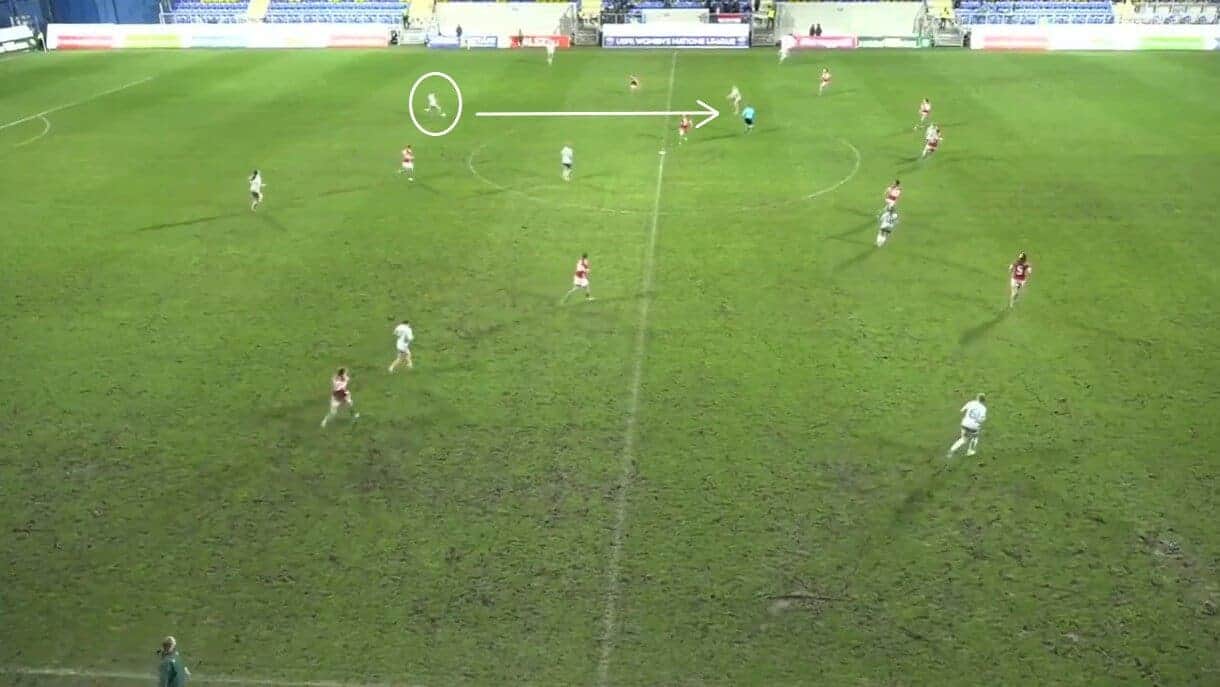
One of the things that indicates that unity is their desire to play on the front foot and to be positive when they have possession, with a desire to be progressive with the ball and to always look to gain territory whenever there is an opportunity to do so.
To make this work to its maximum effect, though, it needs to be a policy that the whole team buys into, and it is clear when watching Northern Ireland’s recent performances that, on the whole, this is the case for them. Here, the ball is in the grasp of the back line, and their first thought is to send the ball forward rather than simply play across the field.
However, what makes this such an essential aspect of their play to point out is the ability to find key threats that it provides them, with this situation seeing the ball arrive at the feet of Reading Women winger Lauren Wade just two phases later, and that shows how every player in the squad has bought into this as something that will lead them to the success that they are striving to attain.
They were aided in this case by Hungary leaving vast amounts of space open between their lines, making the passes much easier to execute. However, it still takes confidence and belief to attempt them. The fact that Northern Ireland have registered a 65.5% accuracy specifically for progressive passes in Oxtoby’s first three matches in charge shows that they do have that at this point in time.
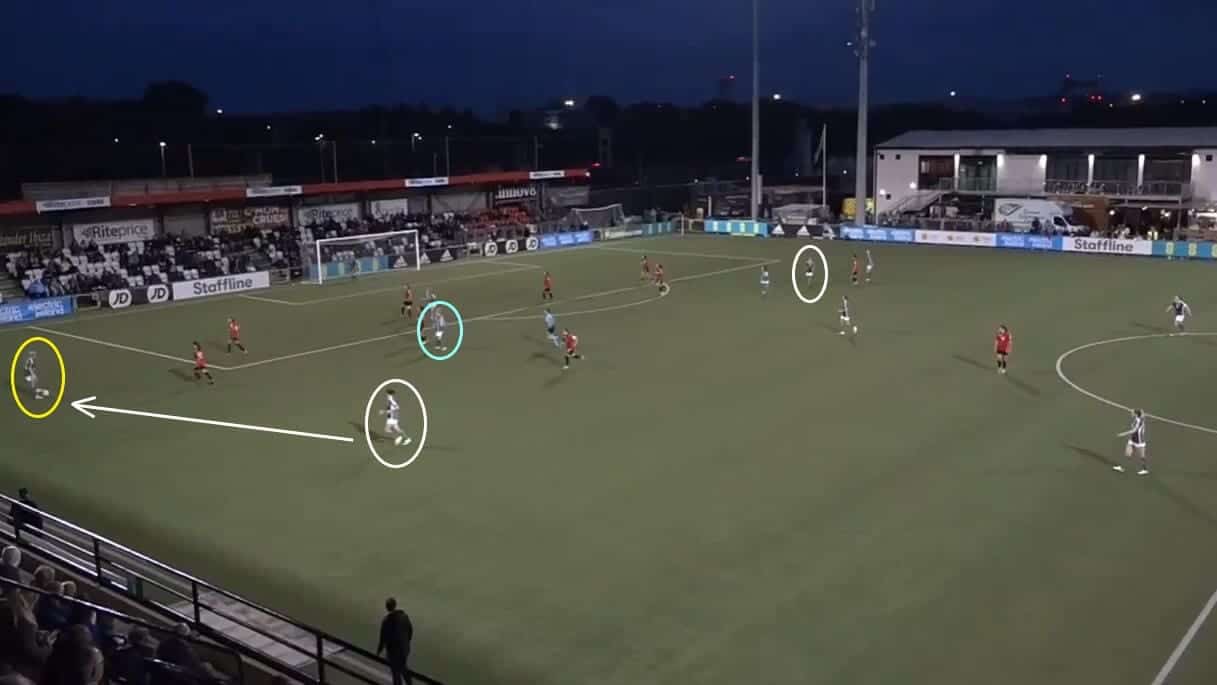
That positive approach is shown in other ways, too, with Northern Ireland committing more players forward when they have the ball in order to give themselves a better chance of converting their opportunities when in promising areas of the field.
This again starts from the back, with the two full-backs essential in enabling this to happen as they push forward once their team has possession and act almost as additional midfielders to facilitate those previously detailed passing sequences. It also allows them to work with the wingers on their side of the field. It is common to see overlapping and underlapping runs as they try to outnumber their opponents and create dangerous attacking opportunities.
With the full-backs, in this case, Demi Vance and Charlton Athletic Women’s Rebecca McKenna, making these runs, those in the midfield have also been able to play higher up the pitch, with them working in closer proximity to the forward line and offering them support where needed.
With the extra players now in the final third, there has also been a greater scope for rotation in their play, with Oxtoby setting her team up in a specific structure but also wanting her players to have the freedom to move around the pitch where they see fit. In this case, that is indicated by winger Kirsty McGuinness drifting into the half-space whilst Glentoran Women midfielder Nadene Caldwell has moved out towards the wing.
This not only creates confusion among the Albanian ranks here due to the increased sense of unpredictability that Northern Ireland carry, but it also allows individual players to get into alternative roles that they are just as capable of operating in, with McGuinness a prime example of that as she has tended to play more centrally for Cliftonville Women this season and has not simply been a winger who has solely set up chances from wider areas through accurate deliveries.
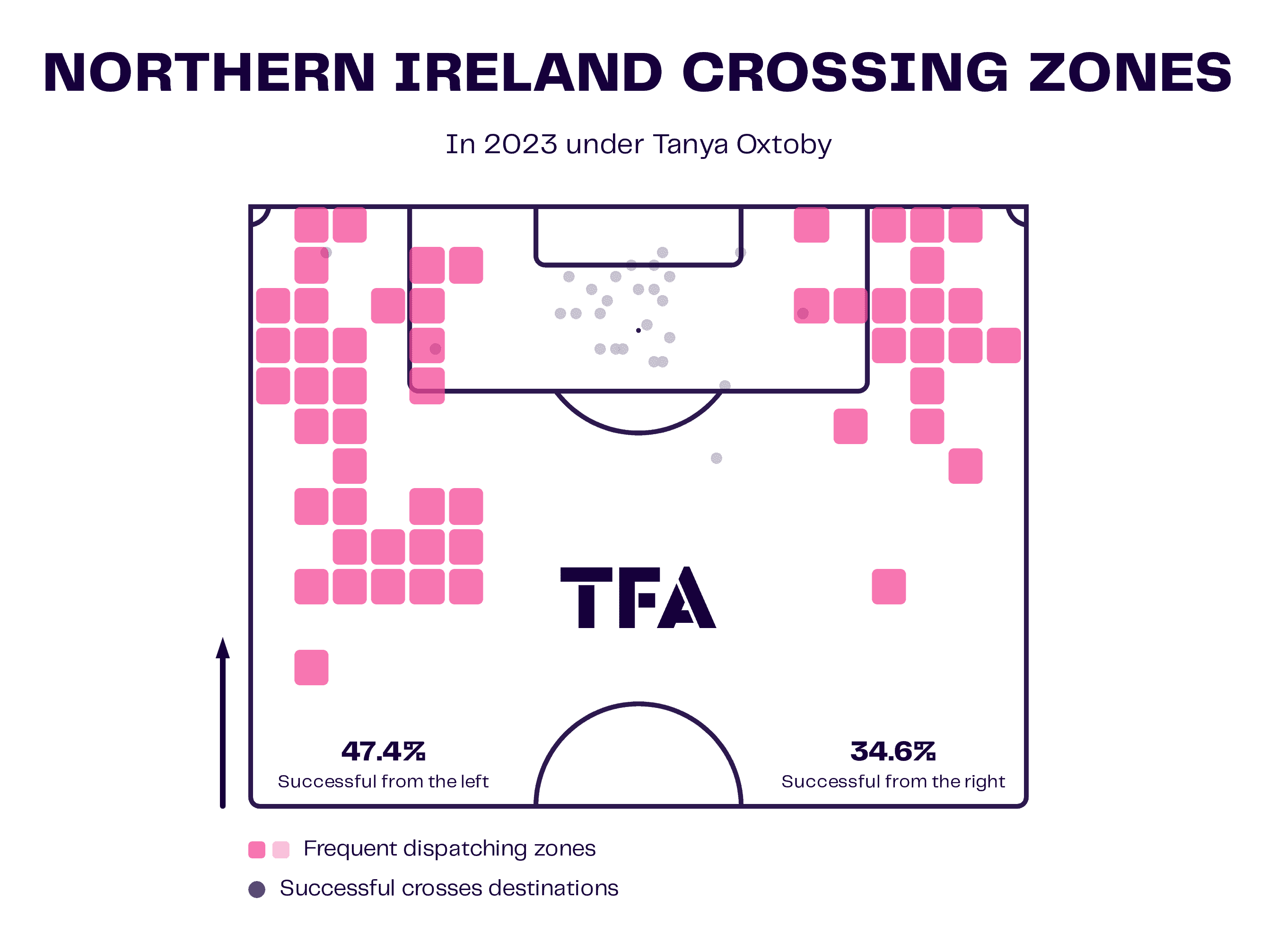
Regardless of who is in the wider areas, though, crossing the ball in has been something that Oxtoby has put a great emphasis on during her short time in charge, and this graphic indicates the variety of areas that Northern Ireland have sent the ball into the middle from.
It is clear to see from the numbers that they have had more success from the left wing than the right, but the critical thing to note here is the fact that they can make early crosses or hold onto the ball for extended periods of play before looking for an option in the middle. That again makes them a more unpredictable opponent to come up against, and the fact that they have so far made a total of 64 crosses under Oxtoby, with 27 finding their intended target, shows that this will be a significant part of their identity under her as they keep looking towards the future.
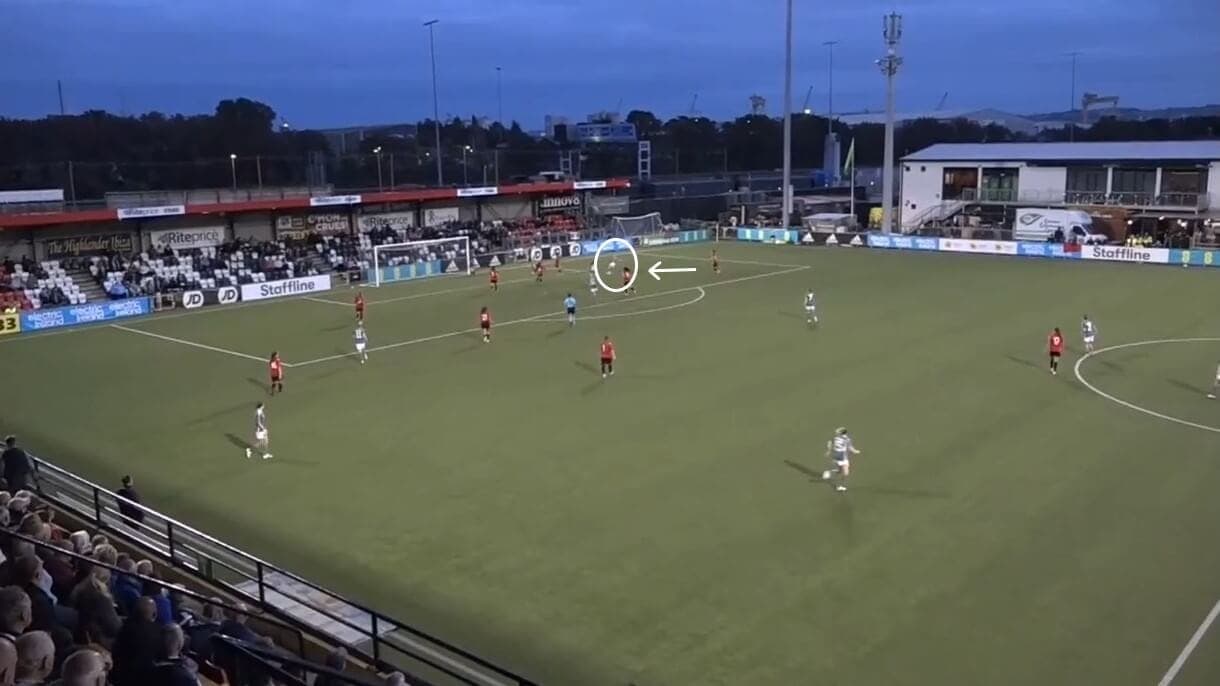
Crossing is not the only responsibility that the wingers have been given, though, with Oxtoby also asking them to make inverted runs and to increase the amount of potential passing options in the middle whenever the ball is on the other side of the field. This is shown here through Racing Louisville’s Rebecca Holloway, who is a left-back by trade but who has tended to feature as a centre-back under Oxtoby, crossing the ball into the goal area from the near side of the pitch and Wade receiving it inside Albania’s goal area, having already come off her wing to get into the middle of the box.
There is another advantage to playing this way, which is that it creates a backstop for any crosses that are overhit or that don’t find their intended target in the middle, and that is another essential detail in Northern Ireland’s play as it allows them to waste fewer chances and to keep the pressure firmly on their opponents through them never having a moment to reset or to catch their breath. Therefore, when looking at how Northern Ireland have improved their attacking play during Oxtoby’s short time in charge, this is another aspect of their tactics that needs to be highlighted.
Defence
The defensive side of things has also been largely positive, but there are apparent differences in the speed at which it is improving compared to their offensive play and the fact that they have conceded two goals on average per game during Oxtoby’s first three matches in charge shows that more time will need to be spent on how they make themselves more challenging to beat once they lose the ball as her tenure progresses.
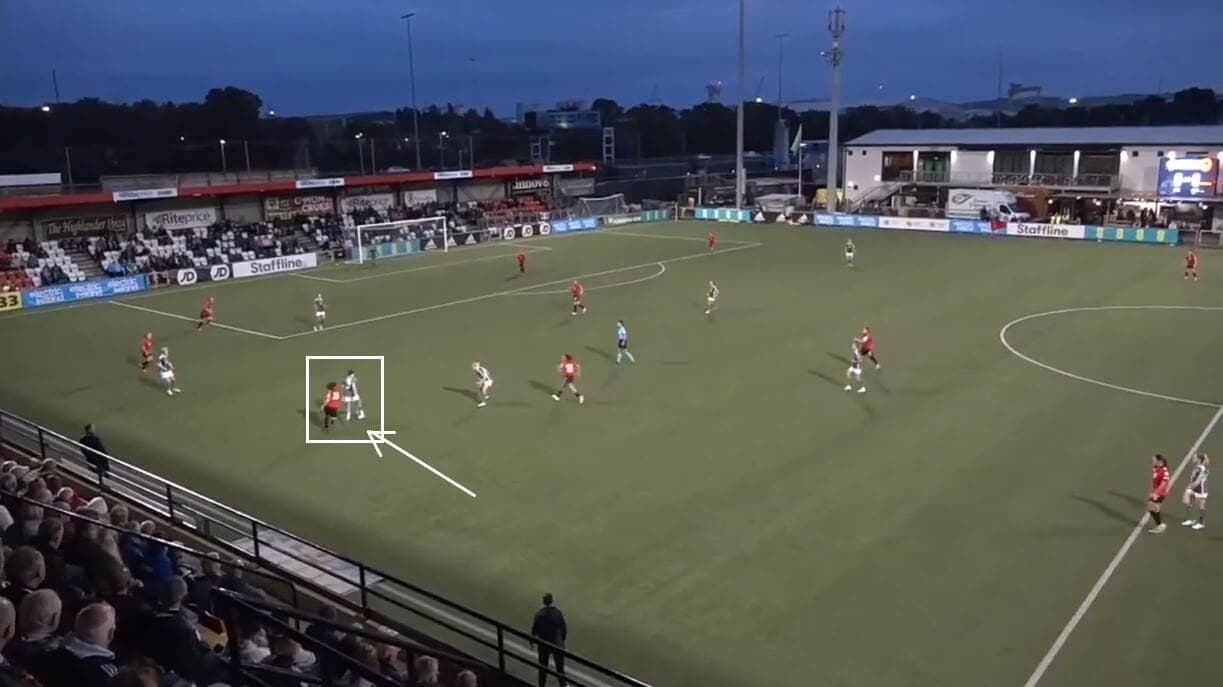
One thing that Oxtoby has demanded from her players is that, where possible, they defend from the front, and making that work is again down to the whole team working together in order to prevent gaps from opening up and to keep as much distance between the ball and the goal as they can.
In this case, Albania have regained possession and are looking to build from the back, but Northern Ireland have anticipated this and have pressed forward to win the ball inside their opponents’ half, preventing them from gaining momentum.
What helps to make this possible here is that, due to the aforementioned desire to push the full-backs into advanced areas of the field, former Rangers Women and Leicester City Women left-back Vance is already high up the pitch and so has not needed to use too much energy up in her attempt to regain the ball. As a result, she can wait for the right moment to make her move and then make the interception at the optimum moment, and this is one situation when everything works out as she secures possession for her side before it arrives at the feet of Luçije Gjini.
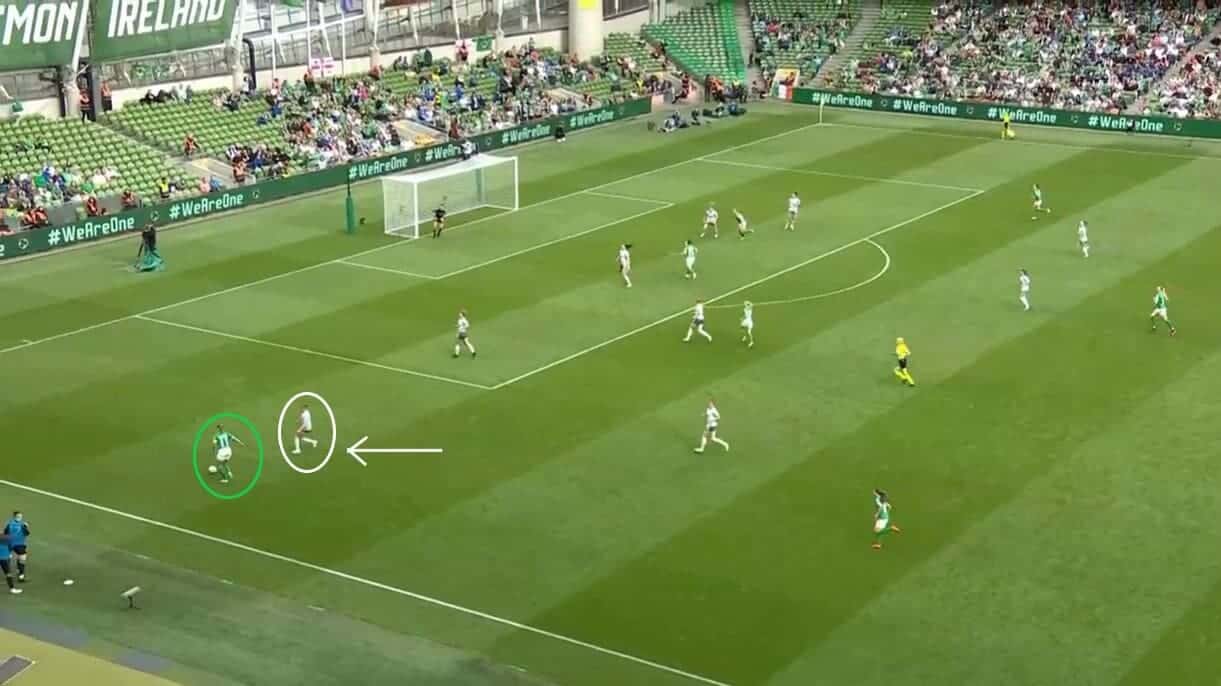
It has not always been possible to defend that way, though, with the match against the Republic of Ireland (RoI), which took place at Dublin’s Aviva Stadium (the first time that the women’s team had played at the ground), one in which Northern Ireland needed to sit back and to play with more of a counterattacking mentality. This was mainly due to the RoI playing with wing-backs, as has been a common theme for them in recent years, and this game saw Everton Women’s Heather Payne and Arsenal Women’s Katie McCabe given those roles and tasked with playing as high up the pitch as possible.
However, this is not to say that Northern Ireland didn’t have a plan to deal with their opponents because what was clear to see was that the two wingers dropped back whenever the ball was on their side of the field and became additional full-backs. In doing so, they hoped to limit the effectiveness of the RoI’s two wing-backs, both of whom are known for their accuracy when sending balls into the central areas.
In this case, it worked out for the visitors as Blackburn Rovers Women midfielder Tyler Toland passed RoI captain McCabe the ball and instantly looked to find a teammate inside the box to aim for. Ordinarily, she would have liked to bide her time and wait for the right opportunity to arrive, but the press that Lewes Women winger Caragh Hamilton has instigated here means that she no longer has that luxury and so has to cross earlier or risk being cut off completely. As a result, the ball doesn’t reach an RoI attacker, and instead, Northern Ireland can clear their lines.
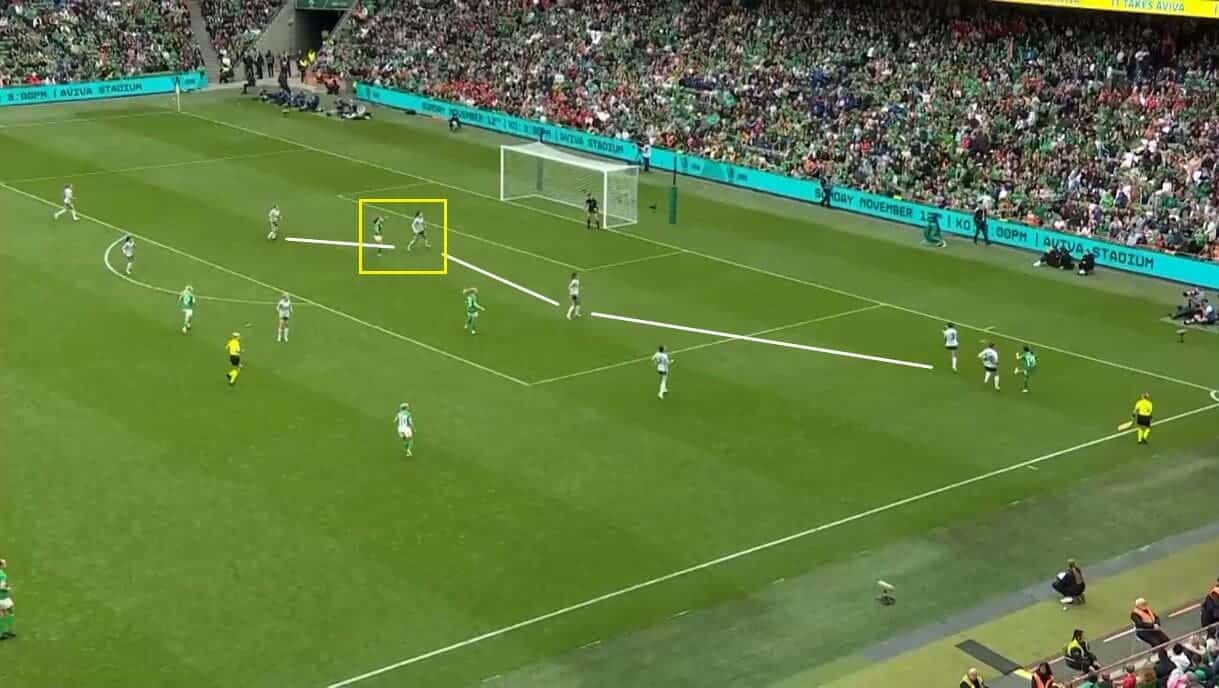
This is another situation when the winger and full-back have teamed up, with Wade moving back to help Vance out and create a numerical advantage against Glasgow City forward Abbie Larkin.
However, the key point to look at here is Northern Ireland’s setup in the middle because there is a hybrid of styles on show here in that the team is set up in a line but is also trying to mark player-to-player, with Durham Women’s Sarah McFadden staying tight to Kyra Carusa and preventing the San Diego Wave striker from having a clear line of sight, making it harder for her to turn Larkin’s cross into the net.
As this was Oxtoby’s first game in charge, it was expected that there would be a certain level of experimentation in their tactics and that the performance would not be entirely coherent, and that is why there is this mix of defensive techniques that led to them ending up with a 3-0 defeat.
As time goes on and the former Chelsea assistant continues to implement her ideas, there will be a clearer identity coming to fruition. However, the fact that they have won 62.36% of their defensive duels and 47.01% of their aerial duels since she came in does indicate that there are positives for her to build on and that, despite the defending still being a little ropey at times, they do have the ability to make themselves a robust side out of possession.
Things to work on
Whilst the points made so far in the scout report have been largely positive, with there clearly being a lot to like about the way that Northern Ireland are playing under Oxtoby at this stage, it would be a lie to say that there are not some things that are currently letting them down and that need addressing, both with and without the ball.
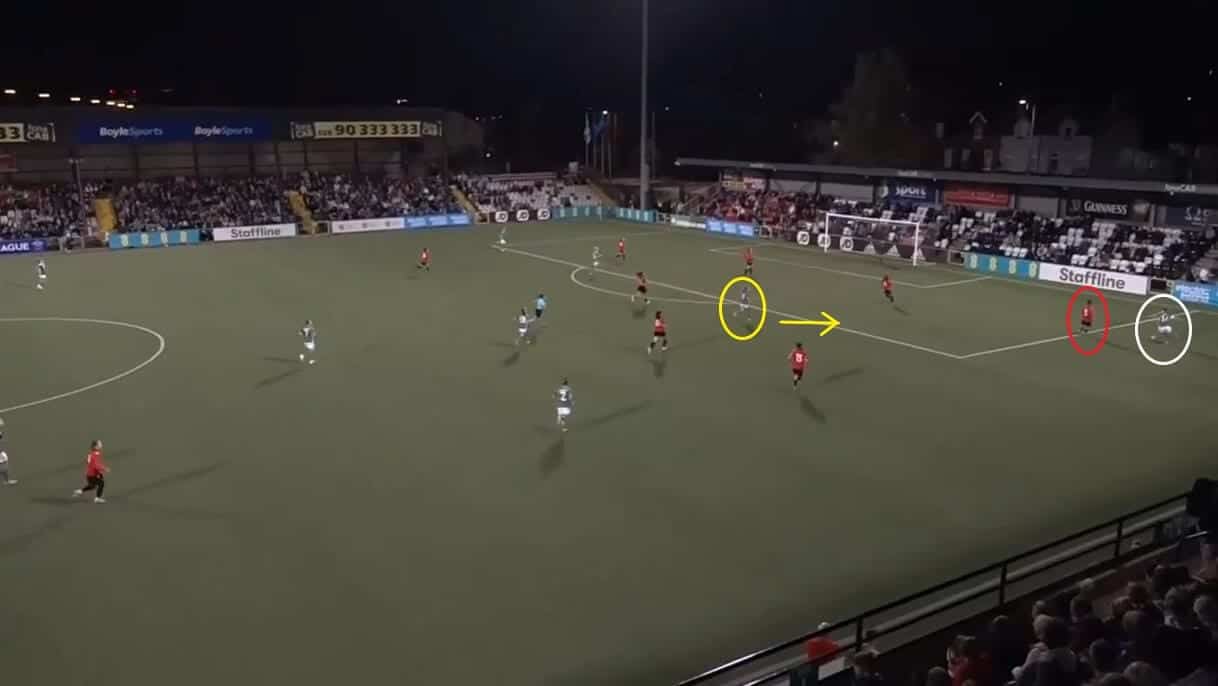
In attack, the main concern will be their lack of productivity, with them only averaging one goal per game so far and not making the most of the chances they create. The issues this leads to were most prominent during their match against Albania at Seaview, with the team trying to move the ball around but not quite having the quality required in the final third to turn their positive build-up play into shots on goal.
What it came down to was individual players taking one touch too many in key areas or not finding a pass at the right time, with Wade under pressure here from left-back Arbenita Curraj and looking to take the ball beyond her Albanian opponent rather than crossing it in.
That in itself was not a problem, but the fact that Wade’s attempted dribble ended with her not connecting with the ball in the way that she would have wanted and overrunning it meant that her next attempt at a cross went backwards and not into the middle. Whilst McKenna was on hand to control the loose pass, the fact that she was not expecting it to come her way meant that she, too, couldn’t find a teammate, and Albania were able to clear their lines, with Northern Ireland squandering a chance to test their opponents.
Oxtoby’s side did control most of the possession in this game and created several promising chances, but they only scored one goal, and that is the critical point. Therefore, being more clinical in games where they are the dominant team will be something that they will need to amend if they are to close the gap between themselves and those who appear at tournament finals consistently.
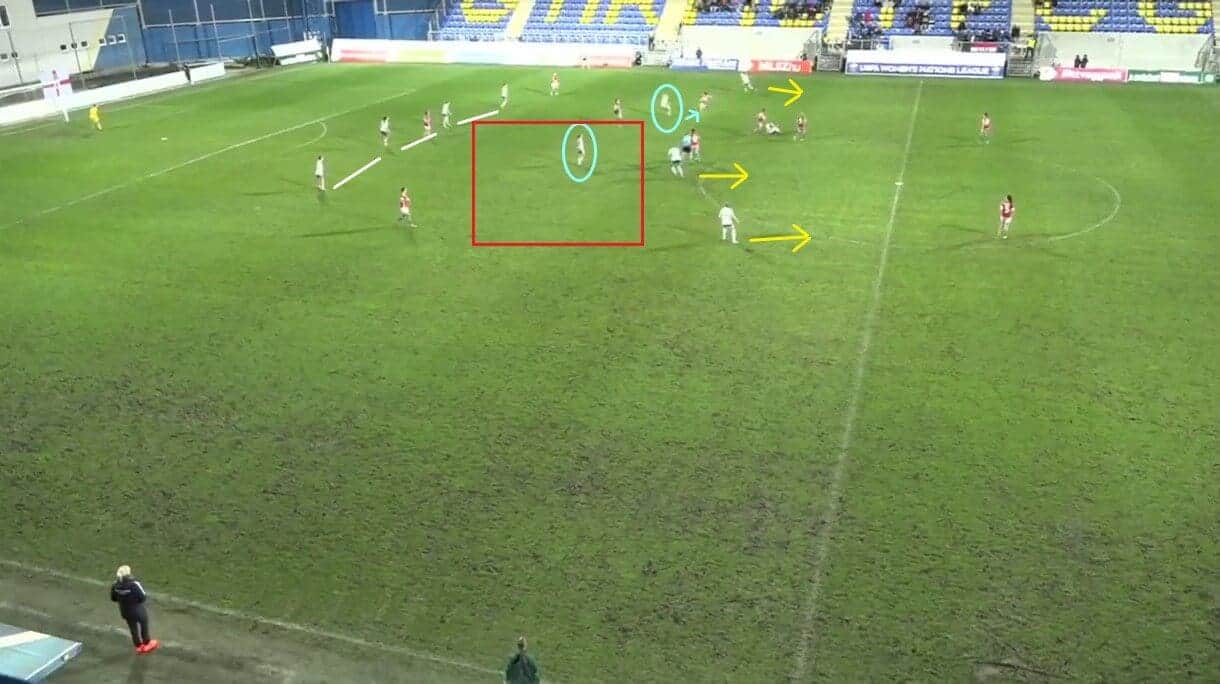
In defence, there has been evidence of a lack of communication at times, not only in the back line but across the whole team, and the trip to Hungary provided plenty of opportunities for their opponents to expose this problem. In this case, some players are looking to press forward and offer the passing options that Northern Ireland want to create. Still, the defensive line is sitting back and isn’t attempting to join them due to Hungary regaining the ball early in the counterattack.
As a result, a gulf has opened up between the two areas of the Northern Irish side, with the two in the double pivot now left open and vulnerable to being overrun by the Hungarian attackers. One of them does try to win the ball and to prevent the home side from moving up the field but is unsuccessful in doing so, and that gives Hungary an advantage and leads to Dóra Süle getting her name on the scoresheet in relatively easy circumstances here.
Hungary played with obvious tactics in Győr (Hungary’s sixth-largest city), with them looking to use Emőke Pápai as a focal point whilst those behind her, which included BK Häcken Dam’s Dóra Zeller, Ferencvárosi Women’s Viktória Szabó, Fiorentina Femminile’s Zsanett Kaján and the aforementioned Süle, roamed free and continually switched the direction of their runs in order to create confusion among the Northern Irish ranks.
With that in mind, it is easy to see how the visitors played directly into their hands in moments like this, and the fact that Hungary only had four shots in this game and all were on target shows how they need to be aware of this going into future games.
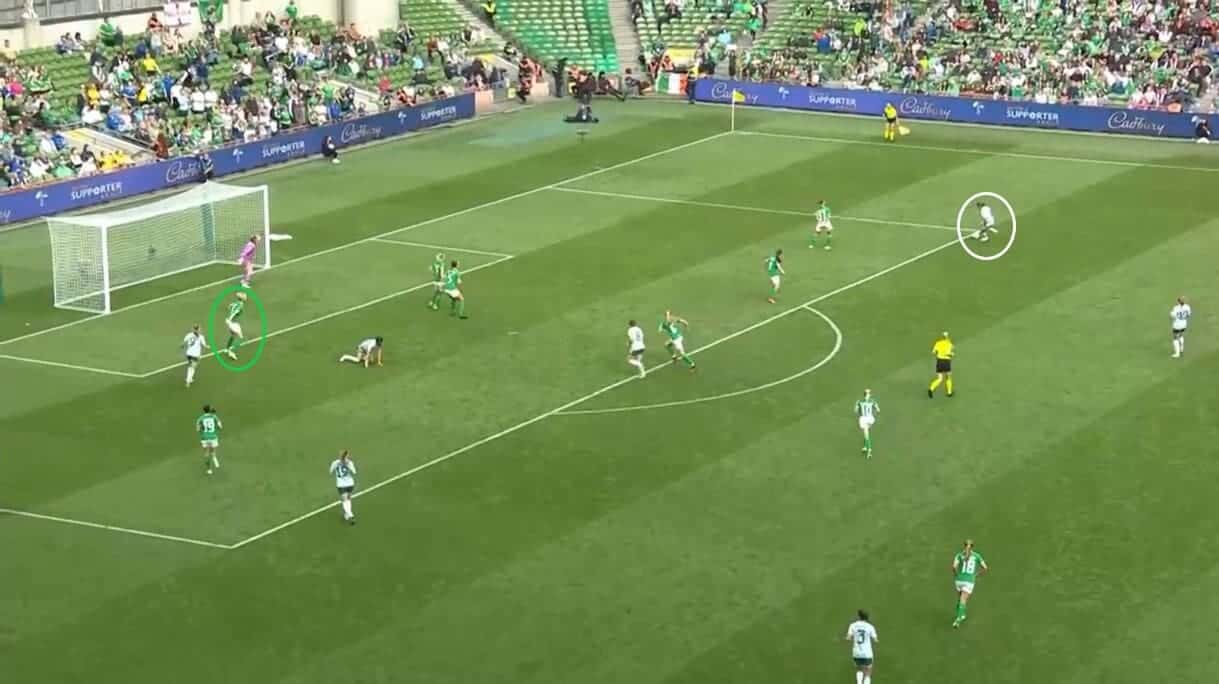
The other thing that has been evident about Northern Ireland so far is that, whilst their ability to cross into the middle has been effective in creating numerous goalscoring opportunities for them, it is, at the moment, their only style of play. They don’t seem to have anything to fall back on when it fails to give them what they want.
This was clear to see against the RoI, with them continually sending in crosses even when they weren’t having the desired effect. This was because the RoI have several aerially dominant players in their back line, including Zürich Frauen’s Diane Caldwell and Birmingham City Women’s Louise Quinn, both of whom were involved here in preventing the deliveries of Glentoran’s Emily Wilson and the Hamilton, as mentioned earlier from finding their intended targets.
Therefore, Oxtoby needs to find an alternative style of play that allows her team to build attacks in another way because not doing so could lead to them leaving matches frustrated with a draw or a defeat when a victory was a possibility.
Conclusion
In conclusion, this tactical analysis has taken a closer look at the start that Northern Ireland have made to life under Tanya Oxtoby, who has been in charge for just over two months and has now overseen four matches with her new side. As has been indicated throughout the analysis, there is already a clear picture being constructed of what the team will look like under her and of the style of play that she wants to implement, and that is a big positive as it can take longer for some managers to get their ideas across to their players and to persuade them to invest in their philosophy.
However, there is no doubt that the honeymoon period is now over, and results do need to start being attained because football is ultimately a results business. Two defeats in four will always be the headline of her time in charge so far. Oxtoby will be aware of this, with her an experienced coach at different levels of the game, but it is also essential that she is given the time to make the changes that she feels are necessary. A 1-1 draw on Tuesday night against Hungary at Seaview shows that if she is afforded the time and patience she needs, the positives they demonstrated can lead to something, and another major tournament finals may not be too far away.




Comments